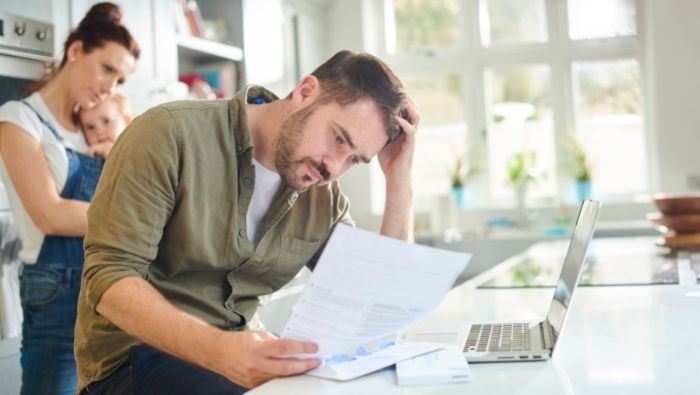3 Tactics That Can Help You Stop Robbing Peter To Pay Paul
by Andrea Norris-McKnight

Each month you use one form of debt to make payment on another or to pay a monthly bill. Try one or more of these strategies to stop robbing Peter to pay Paul.
Dear Dollar Stretcher,
My husband and I are trying to regain control of our finances and become “current” on our bills and pay them on time. But we can’t seem to get out of the “red” because we find ourselves “robbing Peter to pay Paul”. Do you have any suggestions?
Thanks,
Mia G.
We’ve received a number of emails over the years from people struggling to pull themselves out of debt, or just needing advice on how to get to a point where they have more money coming in each month than going out. You can read a few of the responses to these emails by our former editor here:
- When There’s No Money Left for Extras
- Tackling Debt When Bills Exceed Income
- Getting Out of Credit Card Debt When You Can Only Pay the Minimums
But sometimes, I think it can be helpful to hear from others who were struggling financially and found a way out. Below, discover the tactics used by three different Dollar Stretcher readers to get their finances turned around. Maybe their advice and experiences can help you improve your financial situation.
1. The Envelope System
The envelope system I use works great for us, but it did take two or three months to get it working correctly (and it is old school). I took a very close look at all of our bills and how much we spent for each budget category per week. I then made an envelope for each category.
Each week when my husband gets paid, we cash his check and “pay” the envelopes. Then when the bills are due, money should be in the envelope to pay them. Example: We have envelopes for the phone bill, electric bill, streaming services, doctor bills, credit card bill, Christmas, car insurance, etc. I figure how much our insurance is for the year, divide that amount by 12 and “pay” the auto insurance envelope monthly (I round up the amount to the next $5 increment to keep it easy). When the bill comes, I put the cash in the bank and pay it. It’s nice to have that extra “rounded money” left over at the end of the year, too! It comes in handy at Christmas. Same story for every expense.
The credit card bill is a little different because the amount varies from month to month. We pay the balance in full every month. So every time we charge something, we put the cash in the envelope. That way, we have the money to pay the bill in full when it comes.
I also have an envelope for Miscellaneous. We all know that no matter how well we plan, there are always unexpected expenses. It took a while to get this working because you have to pay last month’s bills while you’re starting next month’s bills with your envelope system. Once we finally got it working, we’ve not had any more problems having money to pay bills.
Lynne
Sign Up for Savings
Subscribe to get money-saving content by email that can help you stretch your dollars further.
Twice each week, you'll receive articles and tips that can help you free up and keep more of your hard-earned money, even on the tightest of budgets.
We respect your privacy. Unsubscribe at any time.
2. Pay Off Lowest Balance First
Most financial “gurus” say you should pay off the credit card with the highest interest rate. I found that for me, it was better to pay off the credit card with the lowest balance first (also known as the ‘Snowball” method).
There were two reasons I found that this worked better for me:
- I was used to paying a certain amount on the credit cards, and it didn’t matter what the interest rates were.
- When I paid off the lowest balance credit card using as much “extra” money as I could each month plus the regular amount of payment, I was actually able to see my debt lower over a shorter period of time.
When I got the lowest balance credit card paid off, I then applied all the “extra” money that I had applied to the first credit card, plus the regular amount I had been paying to the second lowest balance credit card and so on. This is what worked for me.
Judi
3. Get Credit Counseling
My husband and I were in the same boat about twelve years ago, and the boat was sinking pretty fast. We first called a financial planner who directed us to the local office of Consumer Credit Counseling.
We met with them and were required to turn over all our credit cards to them, which they cut up. We signed a contract to agree to work with them to get ourselves out of debt in exchange for them contacting our creditors and arranging lower payments for us so we could manage the monthly payments.
Instead of paying our creditors directly, we had to pay the counseling service the total sum due to all our creditors each month, by cashier’s check or money order, no personal checks allowed. They then doled out the appropriate amounts to each of our creditors. I believe this service was free as well. This was a real lifesaver for us and helped us get back on track again and manage our finances much better. We couldn’t believe how irresponsible we had been.
Now, twelve years later, we have a few credit cards, but are keenly aware of where we are credit-wise, and pull the plug on ourselves when we see we may be getting out of line.
Brenda
There is no “one-size-fits-all” solution for financial problems. You may have to try a few of these methods to see what might suit your situation best or explore some of the options we have recommended to other readers (see the links at the top of this article). But one thing everyone must do is to take action. Ignoring the problem definitely won’t help it go away.
Reviewed October 2023
Sign Up for Savings
Subscribe to get money-saving content by email that can help you stretch your dollars further.
Twice each week, you'll receive articles and tips that can help you free up and keep more of your hard-earned money, even on the tightest of budgets.
We respect your privacy. Unsubscribe at any time.
Wouldn't you like to be a Stretcher too?
Subscribe to get our money-saving content twice per week by email and start living better for less.
We respect your privacy. Unsubscribe at any time.
Popular Articles
- 7 Habits of Highly Frugal People
- 5 Simple Budget Cuts That Can Save $200 a Month
- How to Track Down Unclaimed Funds Owed You
- 32 Ways to Save Money on Your Utility Bills
- Do You Need Credit Life Insurance When Buying a New Car?
- How to Maximize Profits When Selling Online
- Staying Motivated to Continue Digging Yourself Out of Debt
On After50Finances.com
- 9 Things You Need to Do Before You Retire
- You Didn’t Save Enough for Retirement and You’re 55+
- When Empty Nesters Reorganize and Declutter Their Home
- Reinventing Your Career in Your 50s or 60s
- What Mature Homeowners Should Know about Reverse Mortgages
- 2 Reasons to Collect Social Security Benefits As Soon As Possible


